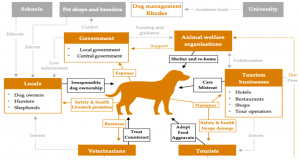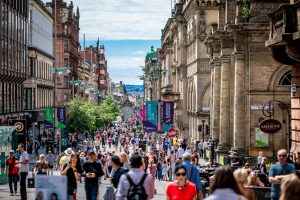Understanding the complexity of a destination is core when developing a new project or new interventions. Besides the understanding phase, there is also the phase of involving all the stakeholders, the assessment phase and so forth. Being successful in destination management is quite hard as destinations are full of complexities and local policies, local culture and values play a big role. Conducting research therefore become mandatory for tackling all the matters above.
There are however many approaches to research in a destination. This article introduces a possible way to design research that is very connected to creativity. Creativity refers to the capacity of the researcher to be curious and open-minded, in order to explore and investigate beyond what is given (the data), aiming at immersing in the complexity of a place and of people in order to create an unimagined future together with the destination.
According to Montuori (2006), a scholar who publishes a great deal on creativity and creative inquiry, this approach on research moves away from the logic of either/or and from the logic of oppositions or polarities, navigating towards the spectrum of opportunities, embracing an intuitive and rational ambiguity, promoting a variety of rich meanings and knowledge related to the topic investigated.
Creativity in research is also about framing research as a creative process (Montuori, 2005), creating what “might be” instead of sticking to “what it is.” The core of creativity in research is to give form to loose ideas during the whole process of the research, ideas that are apparently not interconnected, framing that into possible connections, further understanding and ultimately creating new actions. Paré and Larner (2004) endorse this way of doing research by stating that “research is not simply an act of finding out, but is also always a creating together process” (p. 213).
This orientation is also connected to a framework called Social Construction (Camargo-Borges & Rasera, 2013) inviting researchers not just to raise hypotheses, collect data and make conclusions about a destination but also to embrace a more collaborative approach towards the social actors involved in order to produce useful and contextual meanings. Social Constructionist ideas encourage creativity in research in order to understand and co-create with a destination instead of for a destination, producing more user-centered and context-related findings and directions (Camargo-Borges 2017).
This creative approach to research challenges universal knowledge and its inclination to predict and control, instead inviting a closer look at local knowledge, at different voices and perspectives and at the dynamics of our ever-changing world/society (Gergen, 2015; Anderson, 2014; McNamee & Hosking, 2012). If knowledge is co-created in relationship, in context and in history, this approach to research invites not just an understanding of this creation but also a recreation to new forms of knowledge, focusing on what Gergen (2014) calls future forming research. Future forming research differs from traditional research where the research is understood to be a mirror of reality. In a future forming research, the aim is not to look at what “is there,” but to create new forms of action thereby creating alternative possibilities for society, organizations and community.
To enable this type of research new methods need to be applied. Arts-based research offers a set of methods such as Photovoice, Storytelling, pictures and visuals that invites creativity and engagement in research. Arts-based research can be defined as a form of qualitative research that uses the premises, procedures, and principles of the arts in the investigation of a topic. According to Knowles and Cole (2008), arts-based research is an expanding orientation in research that brings inspiration and representation from the arts to qualitative social science. According to the authors it is a systematic way of “…understanding and examining experience by both researchers and the people that they involve in their studies” (p. 29).
Patricia Leavy (2009), an expert in Arts-Based Research, states that embracing methods that come from the field of arts enable powerful narratives in research as they go beyond rational linguistic representation, thereby amplifying stories and providing a more complex view of a situation or topic.
Creative Research in Uganda
Three researchers (one is the author of this paper) and two NGO’s in Uganda (Hope for Youth Uganda & Health Nest Uganda) engaged in a collaborative creative inquiry. These NGOs work with some communities in Uganda focusing on local developments in healthcare and education. The aim of the inquiry was to explore possibilities for establishing partnerships and to get to know more about the local community from their own perspective. We began with understanding the context by having online virtual meetings together (each of us in our own countries) to get to know each other, our interests, our needs in order to establish the theme of the research.
We entered the field as co-researchers (Irving, 2007), which meant that we were not standing there as experts, but as participants with some expertise that we hoped to combine with the expertise of our partners in Uganda. This understanding phase resulted in a research proposal entitled, “Discovering the Beauty of Uganda”, with the aim to engage in an exploration of the community through the youth’s meanings of their positive experiences and impressions of Uganda.
In the second phase, we were in Uganda all together. We (the researchers) introduced participants to the Photovoice method (Griebling et. al., 2013) and trained them in the context of the research topic. The method builds on the power and potential of photography to enable and encourage participants to be creative and reflective. It invites participants to imagine alternative futures on a specific topic. With the Photovoice method we offered a prompt, which was to take photos of something that was meaningful to them, that had a meaningful story or represented an important experience in their lives. The data collection unfolded, as the participants were absorbed with the topic, the method, and co-created meaning together. We gave digital cameras to 20 young people, aged 8 to 26. They moved around the city and took pictures of what they saw/interpreted as the beauty of Uganda.
We encouraged participants to work interdependently, inviting creativity and imagination as they freely choose what they would like to share about themselves and their surroundings in a visual manner. With their camera, participants were able to explore the place, document and reveal what they appreciate about Uganda and what they would like to share.
During the data collection, they were actually generating (creating) data, in which the interaction participants-method-team promoted the emergence of new ideas and material with which we worked afterwards (analysis phase). The arts-based method used here involved all participants in the research, enabling them to tap into their creativity and invited interaction among themselves as well as with the researchers.
The next phase was to collect all the pictures taken. The participants sat together in small groups and started telling the stories their photos portray. Their stories got richer as they shared them with each other. After choosing some pictures to be printed they managed to find shared meanings and also find what was special about their own experiences and stories. The research project ended with a final exhibition of the pictures together with the stories written in the community park. By sharing the pictures and stories with community members and leaders their meanings were extended and new stories emerged from the interaction.
The findings were framed using the method of Storytelling (Bochner & Rigg, 2014) which creates collective meanings by developing stories together. A story has the power to bring out multiple voices and multiple constructions, building connections and relationships between the persons and the topic.
The example of the research “Discovering the Beauty of Uganda”, shows the potential that creative approaches can bring to research aimed at social impact.
Lessons for Tourism Destination Management (TDM)
Creative research approaches are most valuable for TDM. Through engaging the participants you can understand better a destination from the eyes of the locals (but also through the eyes of any other group you want to focus on) as well as it can open up new ways of being in relation to a place and new possibilities to be created. It leads to “an inquiry space where diverse views can be in dialogue with each other” (Alvesson & Deetz, 2000 in McNamee, 2010, pp. 16-17). It is a powerful way to co-create new conversations, to encourage participants to expand their own view on a topic and to build new actions in the destination.
For TDM creative research opens up possibilities to work with places and communities in a more engaged way, learning from local people, local stories, values and experiences. It can lead to more inclusive projects, where all participants, including the researchers, co-create possible futures together. In turn, inclusive projects promote a sense of ownership, which supports sustainable change as people commit and take care of what belong to them. TDM would benefit from alternative approaches that embrace the complexity of this field, research approaches that are not just focused on controlling of environment, prediction of behavior, but also and specially focused on the co-creation of knowledge among all involved that can engage, motivate and promote sustainable changes. Locality and its people play a fundamental role in the success and sustainability of a project. Embracing creativity can be a powerful way to do research WITH people and NOT for people, involving the destination in every step of the research.





